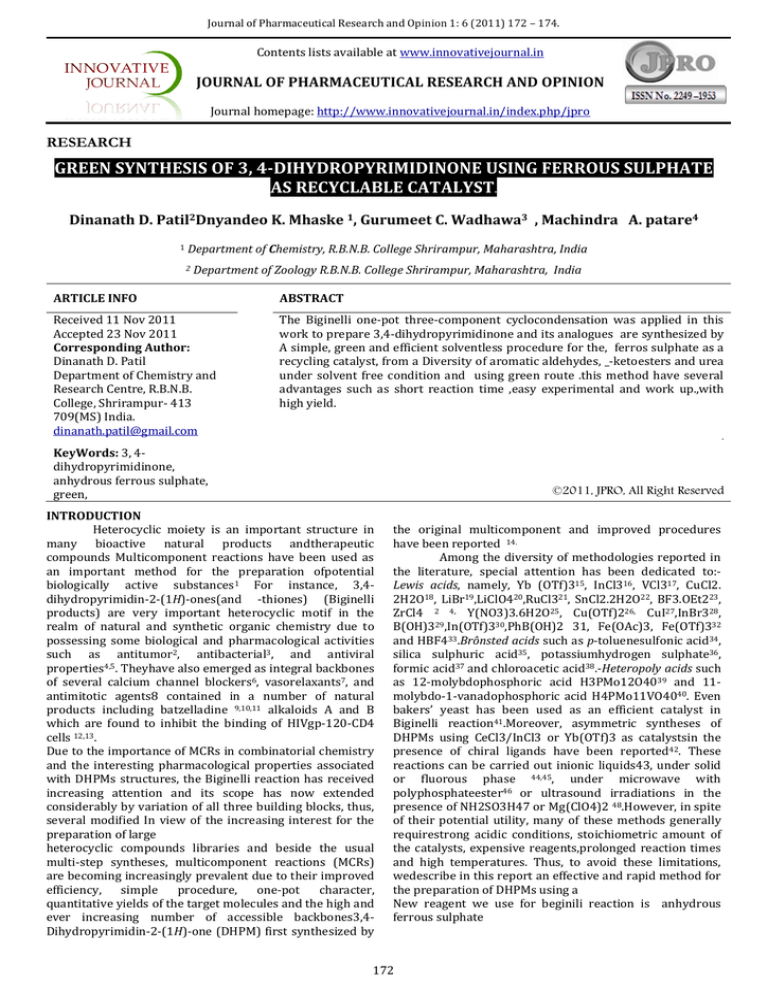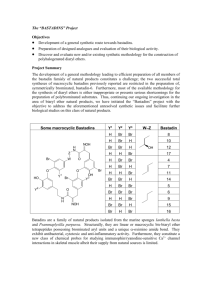
Journal of Pharmaceutical Research and Opinion 1: 6 (2011) 172 – 174.
Contents lists available at www.innovativejournal.in
JOURNAL OF PHARMACEUTICAL RESEARCH AND OPINION
Journal homepage: http://www.innovativejournal.in/index.php/jpro
RESEARCH
GREEN SYNTHESIS OF 3, 4-DIHYDROPYRIMIDINONE USING FERROUS SULPHATE
AS RECYCLABLE CATALYST.
Dinanath D. Patil2Dnyandeo K. Mhaske 1, Gurumeet C. Wadhawa3 , Machindra A. patare4
1
Department of Chemistry, R.B.N.B. College Shrirampur, Maharashtra, India
2
Department of Zoology R.B.N.B. College Shrirampur, Maharashtra, India
ARTICLE INFO
ABSTRACT
Received 11 Nov 2011
Accepted 23 Nov 2011
Corresponding Author:
Dinanath D. Patil
Department of Chemistry and
Research Centre, R.B.N.B.
College, Shrirampur- 413
709(MS) India.
dinanath.patil@gmail.com
The Biginelli one-pot three-component cyclocondensation was applied in this
work to prepare 3,4-dihydropyrimidinone and its analogues are synthesized by
A simple, green and efficient solventless procedure for the, ferros sulphate as a
recycling catalyst, from a Diversity of aromatic aldehydes, _-ketoesters and urea
under solvent free condition and using green route .this method have several
advantages such as short reaction time ,easy experimental and work up.,with
high yield.
.
KeyWords: 3, 4dihydropyrimidinone,
anhydrous ferrous sulphate,
green,
©2011, JPRO, All Right Reserved
INTRODUCTION
Heterocyclic moiety is an important structure in
many bioactive natural products andtherapeutic
compounds Multicomponent reactions have been used as
an important method for the preparation ofpotential
biologically active substances1 For instance, 3,4dihydropyrimidin-2-(1H)-ones(and -thiones) (Biginelli
products) are very important heterocyclic motif in the
realm of natural and synthetic organic chemistry due to
possessing some biological and pharmacological activities
such as antitumor2, antibacterial3, and antiviral
properties4,5. Theyhave also emerged as integral backbones
of several calcium channel blockers6, vasorelaxants7, and
antimitotic agents8 contained in a number of natural
products including batzelladine 9,10,11 alkaloids A and B
which are found to inhibit the binding of HIVgp-120-CD4
cells 12,13.
Due to the importance of MCRs in combinatorial chemistry
and the interesting pharmacological properties associated
with DHPMs structures, the Biginelli reaction has received
increasing attention and its scope has now extended
considerably by variation of all three building blocks, thus,
several modified In view of the increasing interest for the
preparation of large
heterocyclic compounds libraries and beside the usual
multi-step syntheses, multicomponent reactions (MCRs)
are becoming increasingly prevalent due to their improved
efficiency,
simple
procedure,
one-pot
character,
quantitative yields of the target molecules and the high and
ever increasing number of accessible backbones3,4Dihydropyrimidin-2-(1H)-one (DHPM) first synthesized by
the original multicomponent and improved procedures
have been reported 14.
Among the diversity of methodologies reported in
the literature, special attention has been dedicated to:Lewis acids, namely, Yb (OTf)315, InCl316, VCl317, CuCl2.
2H2O18, LiBr19,LiClO420,RuCl321, SnCl2.2H2O22, BF3.OEt223,
ZrCl4 2 4, Y(NO3)3.6H2O25, Cu(OTf)226, CuI27,InBr328,
B(OH)329,In(OTf)330,PhB(OH)2 31, Fe(OAc)3, Fe(OTf)332
and HBF433.Brônsted acids such as p-toluenesulfonic acid34,
silica sulphuric acid35, potassiumhydrogen sulphate36,
formic acid37 and chloroacetic acid38.-Heteropoly acids such
as 12-molybdophosphoric acid H3PMo12O4039 and 11molybdo-1-vanadophosphoric acid H4PMo11VO4040. Even
bakers’ yeast has been used as an efficient catalyst in
Biginelli reaction41.Moreover, asymmetric syntheses of
DHPMs using CeCl3/InCl3 or Yb(OTf)3 as catalystsin the
presence of chiral ligands have been reported42. These
reactions can be carried out inionic liquids43, under solid
or fluorous phase 44,45, under microwave with
polyphosphateester46 or ultrasound irradiations in the
presence of NH2SO3H47 or Mg(ClO4)2 48.However, in spite
of their potential utility, many of these methods generally
requirestrong acidic conditions, stoichiometric amount of
the catalysts, expensive reagents,prolonged reaction times
and high temperatures. Thus, to avoid these limitations,
wedescribe in this report an effective and rapid method for
the preparation of DHPMs using a
New reagent we use for beginili reaction is anhydrous
ferrous sulphate
172
Wadhwa et. al/ Green synthesis of 3, 4-dihydropyrimidinone using ferrous sulphate as recyclable catalyst.
EXPERIMENTAL
Melting points were measured thiles tube and
parrafine bath apparatus and are uncorrected. 1H and 13C
NMR spectra were recorded on a BRUKER AVANCE DPX
spectrometer at 250 and 62.9 MHz, respectively. NMR
spectra were obtained on solutions
General procedure
A mixture of aldehyde (1.0 mmol), _-ketoester (1.0
mmol), urea (1.5 mmol) and a catalytic amount of
anhydrous ferrous sulphate
(5 mol%) was taken is pristel and mortar for the
appropriate time as indicated in Table 1. Upon completion
of the reaction, as indicated by TLC, the reaction mixture
was cooled to room temperature, poured onto crushed ice
and additionally stirred for several minutes.
The resulting solid was filtered under suction,
washed with cold ethanol (4 mL) and recrystallized from
hot ethanol to afford the pure product. In most cases, the
crude product was dried under vacuum pump and shown
essentially the same purity as the recrystallized sample.
Finally, the aqueous phase was evaporated, and the catalyst
anhydrous ferrous sulphate was recovered.
All compounds obtained according to this protocol
were characterized and identified by their melting points
and NMR spectra in comparison to those reported in the
literature. The results are summarised in Table 1
RESULT AND CONCLUSION
We would like to disclose here our preliminary
results using the inexpensive, easily available and
recovered catalyst, anhydrous ferropus sulphate for the
preparation
of
3,4-dihydropyrimidin-2(1H)onesdihydropyrimidin-2-(1H)-ones (and -thiones) as
biologically interesting compounds via the condensation of
aldehyde with _-ketoesters and urea or thiourea. The
advantages of this method are high yields, relatively short
reaction times, low cost, simple experimental and as
isolation procedures, and finally, it is in agreement with the
green chemistry protocols. It is noted that this catalyst is
the first derivative of lead employed to promote the
Biginelli reaction. Therefore, it will be the leader file of
other lead derivatives which have never been the subject of
investigation up to now.
In order to improve yields, some experimentation
with respect to the molar ratio of reactants and the nature
of the solvent were examined. The best results to produce
good to excellent yields (70-96%) of dihydropyrimidinone
4, were achieved on using a 1/1.5/1 molar ratio of
aldehyde 1, urea 2 and 1,3-dicarbonyl compound 3 in the
presence of 5 mol% of Pb(NO3)2 in one-pot condensation
employing refluxing CH3CN (Scheme 1). The results are
summarized in
Table 1. Apparently, under these conditions, the nature of
the substituent in the aromatic moiety does not affect
significantly the yield of the reactions. As can be seen from
data in Table 1, in all cases studied, the three-component
reaction with both aromatic aldehydes carrying either
electron-donating or electron-withdrawing substituents,
heteroaromatic aldehydes and even alkylsubstituted
aromatic aldehydes, proceeded smoothly giving the
corresponding dihydropyrimidinones in high yields.
SPECTRAL ANALYSIS
4-(3-Chlorophenyl)-5-ethoxycarbonyl-6-methyl-3,4dihydropyrimidin-2(1H)-one: M.p. 190-193°C, 1H NMR
(DMSO-d6): _ (ppm) = 9.24 (s, 1H, NH), 7.77 (s, 1H, NH),
7.36-7.17 (m, 4H, C6H4), 5.14 (s, 1H, CH), 3.98 (q, J = 7.0 Hz,
2H, CH2CH3), 2.24 (s, 3H,CH3), 1.08 (t, J = 7.0 Hz, 3H,
OCH2CH3); 13C NMR (DMSO-d6): _ (ppm)= 165.2, 151.9,
148.9, 147.2, 132.9, 130.4, 27.2, 126.2, 124.9, 98.7, 59.3,
53.6, 17.8, 14.0; IR (KBr) (_max cm-1) 3275,3167, 2990,
1781, 1687, 1572, 1492, 1300, 1192, 778
5-Acetyl-4-(4-methoxylphenyl)-6-methyl-3,4dihydropyrimidin-2(1H)-one: M.p. 182-183 °C, 1H NMR
(DMSO-d6): _ (ppm)= 9.17 (s, 1H, NH), 7.78 (s, 1H, NH),
7.19-7.13 (m, 2H, CHarom), 6.91-6.85 (m, 2H, CHarom ),
5.21 (s, 1H, CH), 3.74 (s, 3H, COCH3),2.29 (s, 3H, OCH3),
2.09 (s, 3H, CH3); 13C NMR (DMSO-d6): _ (ppm) = 195.0,
158.9,152.6, 148.4, 136.7, 128.1, 114.3, 110.1, 55.5, 53.7,
30.6, 19.3.
5-Ethoxycarbonyl-4-(2-methoxyphenyl)-6-methyl-3,4dihydropyrimidin-2(1H)-one: M.p. 258-259°C, 1H NMR
(DMSO-d6): _ (ppm)= 9.12 (s, 1H, NH), 7.56 (s, 1H, NH),
7.33-7.24 (m, 1H, CHarom), 7.07-7.01(m, 2H, CHarom),
6.93-6.57(m,1H, CHarom), 5.58 (s, 1H, CH),4.04 (q, J = 7.04
Hz, 2H, OCH2CH3 ), 3.87(s, 3H, OCH3), 2.07 (s, 3H, CH3),
1.06 (t, J =7.04 Hz, 3H, OCH2CH3); 13C NMR (DMSO-d6): _
(ppm)= 165.6, 156.6, 152.6, 148.5, 131.8, 129.3, 127.1,
120.3, 111.0, 108.2, 65.0, 55.2, 49.1, 14.8, 14.3; IR (KBr)
(_max cm-1) 3224, 3109, 2928, 2848, 1721, 1677, 1522,
1432, 1274, 759.
Observation table
Sr
Aldehyde
.
1
2
3
4
5
6
7
8
9
10
11
12
13
14
15
2-Me-C6H4
2-MeO-C6H4
(3-HO, 4-MeO)3-Me-C6H4
4-MeO-C6H4
3-Cl-C6H4
4-Me-C6H4
3-F-C6H4
4-HO-C6H4
2-MeO-C6H4
2-ethyl -C6H4
2-NO2-C6H4
3-NO2-C6H4
4-NO2-C6H4
4-MeO-C6H
Reaction
time in
Min.
50
50
60
45
55
40
55
45
60
65
65
45
40
40
60
Physical
constant
(m.p.)in
0C
204-208
200-204
253-258
183-186
225-232
200-202
193-198
210-215
207-210
235-238
205-207
256-258
256-258
256-258
252-254
%
yield
77
87
80
78
75
67
65
64
68
78
67
88
84
85
72
REFERENCES
1 . Besoluk S, Kucukislamoglu M, Nebioglu M, Zengin M and
Arslan M, J Iran ChemSoc., 2008, 5, 62.
2. Reddy C V, Mahesh M, Raju P V K, Babu T R and Reddy V
V N, Tetrahedron Lett.,2002, 43, 2657.
3 . Xu H and Wang Y G, J Chem Res., (S), 2003, 377.
4 . Sun Q, Wang Y, Ge Z, Cheng T and Li R, Synthesis, 2004,
1047.
5 . Zheng R W, Wang X X, Xu H and Du J X, Synth Commun.,
2006, 36, 1503.
6 . Ranu B, Hajra A and Jana U, J Org Chem., 2000, 65, 6270.
7 . Hsaninejad A, Zare A, Sharghi H and Shekouhy M,
ARKIVOC, 2008, (xi), 64.
8 . Hasaninejad A, Zare A, Sharghi H, Niknam K and
Shekouhy M, ARKIVOC, 2007,(xiv), 39.
9 . Eshghi H, Rafei M and Karimi M H, Synth Commun., 2001,
31, 771.
10. Hajipour A R, Kooshki B and Ruoho A E, Tetrahedron
Lett., 2005, 46, 5503.
11. Eshghi H and Hassankhani A, Synth Commun., 2006, 36,
2211.
173
Wadhwa et. al/ Green synthesis of 3, 4-dihydropyrimidinone using ferrous sulphate as recyclable catalyst.
12 . Eshghi H, Rafei M, Gordi Z and Bohloli M, J Chem Res.,
(S), 2003, 763.
13. Hajipour A R, Zarei A, Khazdooz L, Pourmousavi S A,
Mirjalili B F and RuohoPhosphorus, Sulfur and Silicon, 2005,
180, 2029.
14 . Eshghi H and Gordi Z, Phosphorus, Sulfur and Silicon,
2005, 180, 1553.
15 . Mirjalili M, Zolfigol M and Bamoniri A, Phosphorus,
Sulfur and Silicon, 2004, 179,
16 . Junk B, Pernat T and Kappe C O, Molecules, 2000, 5,
227.
17. Atwal K S, Rovnyak S C, Kimball S D, Floyd D M,
Moreland S, Swanson B, Gougoutas J Z, Schwartz J, Smillic K
M and Malley M F, J Med Chem., 1990, 33, 2629.
18 . Biginelli P, Gazz Chim Ital., 1893, 23, 360.
19. Hurst E W and Hull, R, J Med Pharm Chem., 1961, 3,
215.6. Kappe C O, Shishkin O V, Uray G and Verdino P,
Tetrahedron, 2000, 56, 1859.
20 . Atwal K S, Rovnyak G C , Schwartz J, Moreland S,
Hedberg A, Gougoutas J Z,Malley M F and Floyd D M, J Med
Chem., 1990, 33, 1510.
21. Horovitz Z P (E.R. Squibb, and Sons), Eur Pat Appl.,
1990, EP 400, 665 [Chem.Abstr., 1991, 115, 64793].
22 . Crosson C E, Potter D E, Ondetti M A, Floyd D and Aberg
G, (Houston
Biotechnology, Inc.; Squibb E R, and Sons) PCT Int. Appl. WO
1990, 06,118 [Chem.Abstr.,1991, 114,157224 w].
23. Stefani H A, Oliveira C B, Almeida R B, Pereira C M P,
Braga R C, Cella R, BorgesV C, Savegnago L and Nogueira C
W, Eur J Chem., 2006, 41, 513.
24. Patil A D, Kumar N V, Kokke W C, Bean M F, Freyer A J,
De brosse C, Mai S,Truneh A, Faulkner D J, Carte B, Breen A
L, Hertzberg R P, Johnson R K, Westly JW and Potts B C, J
Org Chem., 1995, 60, 1182.
25. Overman L E, Robinowitz M H and Renhowe P A, J Am
Chem Soc., 1995, 117, 2657.
26 . (a) Verale R, Alam M M and Adapa S R, Synlett., 2003,
67; (b) Lu J, Bai Y, Wang ZJ, Yang B and Ma H, Tetrahedron
Lett., 2000, 41, 9075; (c) Reddy C V, Mahesh M, Raju PV,
Babu T and Reddy V V, Tetrahedron Lett., 2002, 43, 3657;
27. Eshghi H, Rafei M and Karimi M H, Synth Commun.,
2001, 31, 771.
28. Fu N, Yuan Y, Cao Z, Wang S, Wang J and Peppe C,
Tetrahedron, 2002, 58, 4801.
29. Tu S J, Fang F, Miao C B, Jiang H, Shi D Q and Wang X S,
Tetrahedron Lett., 2003,
44, 6153.
30. Ghosh R, Maiti S and Chakraborty A, J Mol Cat., 2004,
47, 217.
31. Debache A, Boumoud B, Amimour M, Belfaitah A,
Rhouati S and Carboni B,Tetrahedron Lett., 2006, 47, 5697.
695 A. DEBACHE et al.
32. Adibi H, Samimi K A and Beygzadeh M, Catal Commun.,
2007, 8, 2119.
33. Chen W Y, Qin S D and Jin J R, Catal Commun., 2007, 8,
123.
34. Jin T, Zhang S and Li T, Synth Commun., 2002, 32, 1847.
35. Salehi P, Dabiri M, Zolfigol M A and Fard M A B,
Tetrahedron Lett., 2003, 44, 2889.
36. TU S, Fang F, Zhu S L, Zhang T X and Zhuang Q, Synlett.,
2004, 53.
37. Jiang C and Qi Dong You, Chin Chem Lett. 2007, 18,
647.38.
38. Yu Y, Liu D, Liu C and Lu G, Bioorg Med Chem Lett., 2007,
17, 3508.
39. Heravi M M, Bakhtiari K and Bamoharram F Z, Catal
Commun., 2006, 7, 373.
40. Maradur S P and Gokavi G S, Catal Commun., 2007, 8,
279.
41. Kumar A and Maurya R A, Tetrahedron Lett., 2007, 48,
4569.
42. (a) Munoz-Muniz O and Juaristi E, Arkivoc, 2003, 9, 16;
(b) Huang Y, Yang F and
Zhu C, J Am Chem Soc., 2005, 127, 16386.
43. Peng J and Den Y g, Tetrahedron Lett., 2001, 42, 5917.
44. Wipf P and Cunningham A, Tetrahedron Lett., 1995, 36,
7819.
45. Studer A, Jeger P, Wipf P and Curran D P, J Org Chem.,
1997, 62, 2817.
46. Li J T, Han J F, Yang J H and Li T S, Ultrasonics
Sonochemistry, 2003, 10, 119.
47. Ranu B C, Hajra A and Jana U, J Org Chem., 2000, 65,
6270.
48. Lu J, Bai Y, Yang B and Ma H, Tetrahedron Lett., 2000,
41, 9075
.
174




